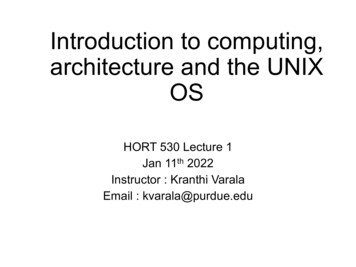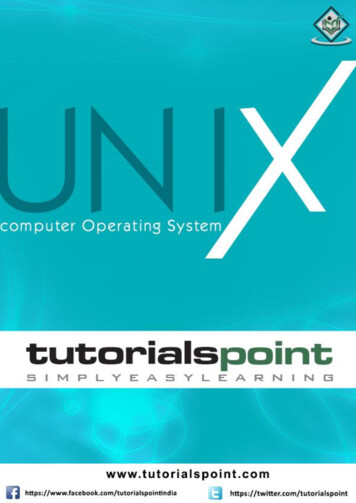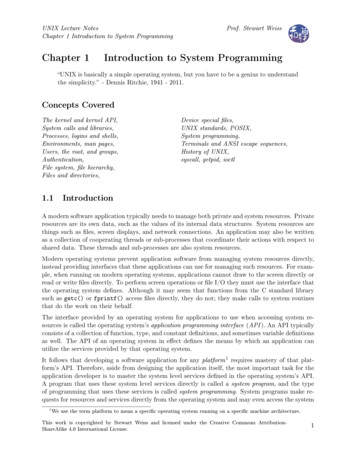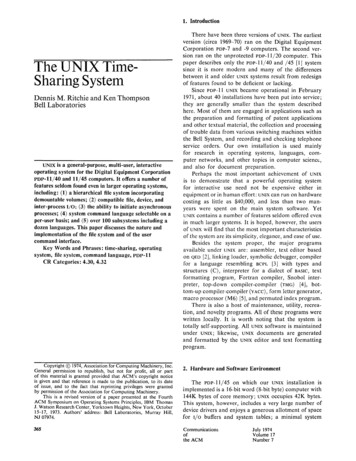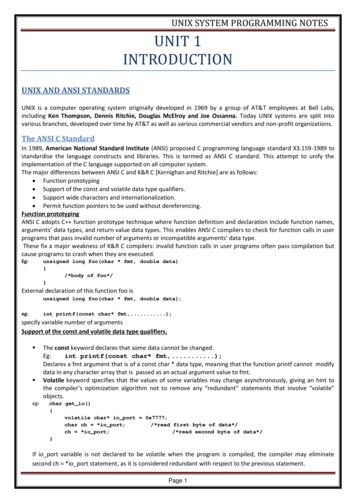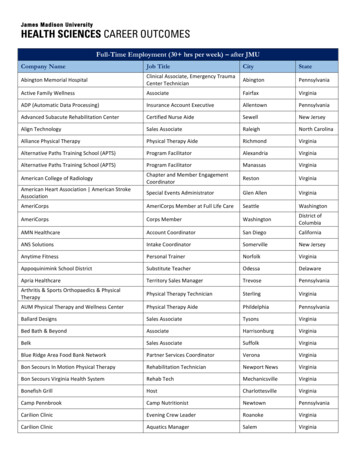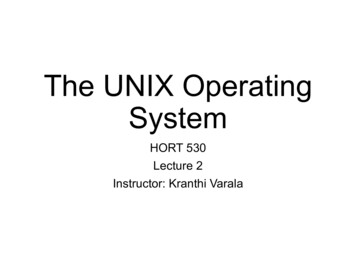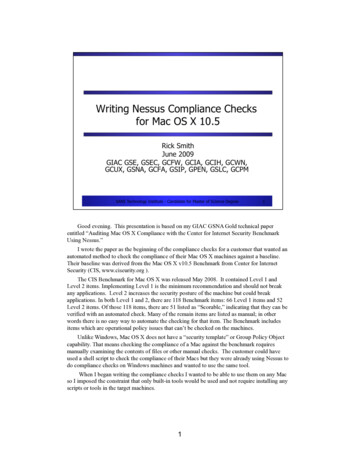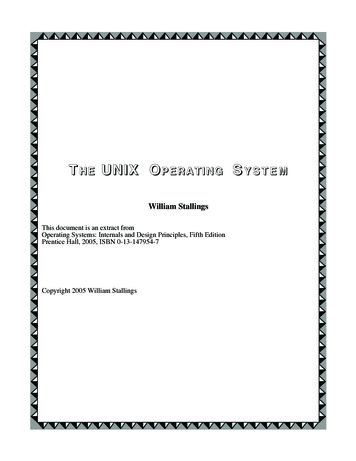
Transcription
The UnixOperating SystemSE 101Spiros Mancoridis
What is an OS?An operating system (OS) is software thatmanages the resources of a computerLike most managers, the OS aims to manageits resources in a safe and efficient wayExamples of computer resources are: CPU,RAM, disk memory, printers, displays,keyboard, mouse, etcThe OS also isolates users and applicationprogrammers from the underlying computer
Operating SystemsMicrosoft WindowsUnix
OS ArchitectureWithout an OS, every application would have toimplement some part of this software hierarchy .
UnixA popular multi-user, multi-tasking OSAttributes: stability, portability, securityCreated at Bell Labs by Dennis Ritchie and KenThompson (won the ACM Turing Award in 1983)Unix is considered one of the greatestachievements in computer scienceHas been around since the 1960s in various forms,e.g., AIX, SCO Unix, SunOS, FreeBSD, OpenBSD,NetBSD, Linux, Mac OS X
UnixMultiuser and MultitaskingToolbox philosophyConcise syntaxDesigned by programmers for programmers
1983 ACM TurningAward (Unix)ACM is the Association for ComputingMachineryWorld’s largest educational and scientificcomputer societyThompson and RitchieYou can become a student member toowww.acm.orgThe ACM awards the Turing Awardevery year. It is the “Nobel Prize” ofcomputingNamed after british mathematicianAlan M. Turing (1912-1954)Alan M. Turing
Unix KernelIncludes device drivers for computer hardwaredevices, e.g., graphics cards, network cards, disksA device driver is a program that allows computerprograms to interact with hardware devicesCPU and memory managementFile system managementImplements system calls that can be used byapplication programs and system utilities
What’s inside the Box?The von Neumann ArchitectureThe OS hides this complexity from the programmer
Unix Shells and GUISShells are used for commandline input/output to and fromuserse.g., sh (Bourne shell), bash(Bourne again shell), csh (Cshell), ksh(Korn shell)GUIs are used for graphical I/Oe.g., Linux KDE, GNOME, MacOS Leopard
Unix System UtilitiesSystem utilities are specialized software tools(commands) e.g.,ls, cp, grep, awk, bc, wc, more, rm, mkdir, .Daemons provide remote network andadministration services e.g.,ssh (remote login)lpd (remote printing)httpd (serves web pages)
Unix ApplicationProgramsThis is the software that users commonlyinteract with e.g.,vi and emacs (text editors)gcc (GNU C compiler)javac (Java compiler)java (Java run time virtual machine system)
What is a programminglanguage?A programming language is an artificiallanguage designed to express computationsthat will be executed on a computerProgramming languages have a syntax (form)and semantics (meaning)Java and C are example programminglanguages
What is a compiler?A compiler is a computer program that transforms human readablesource code of another computer program into machine readable codethat a computer can execute.The act of transforming source code into machine code is calledcompilation.package com.javadb.examples;import java.util.Arrays;import java.util.List;import java.util.Iterator;public class Main {public static void main(String[] args) {String[] array {"Programming", "is", "cool"};List String list Arrays.asList(array);Iterator String iterator list.iterator();while (iterator.hasNext()) {System.out.println(iterator.next());}}}Java Source CodeJava Compilation Process
What is a VirtualMachine?A virtual machine (VM) is a software implementationof a computer that executes programs like a physicalcomputerA system VM implements a complete computer thatcan support the execution of a real OS (e.g., vmware,KVM)A process VM is designed to run a single program(e.g., Java VM)Improves program portability, i.e., the ability toreuse software on a different platform with little orno modification
Logging into Unixlogin: type your user id password: type your password pwd/home/spiros exit
Logging into Unixuserid is the unique name of the userpassword can be changedpassword should only be known by usersystem staff does not know user password, butthey have the power to change itUnix is case sensitive
passwords . domake sure no one is looking while you enteryour passwordchange your password oftenchoose a password that you can rememberuse at least 8 characters (letters) in yourpasswordMix letters (upper and lower case) with digitsand punctuation
Passwords . Don’tuse a word that can be found in a dictionaryuse a namekeep your password written on a piece ofpaperuse control charactersuse personal information (e.g., address,birthday, name of pet)ever give your password to anybody
changing passwordUse the Unix passwd commandYou will be prompted for both your currentpassword (once) and your new password(twice)change your initial password immediately
Logging out of unixlogoutleaves the systemexitquits the shell Dsame as logout, but often disabled
Unix Commands command -options targetsman man (a manual on the Unix manual)There should be a man page for every Unixcommand e.g., man lsRead the man pages, they are very useful andconvenient
Some Unix commandspasswddatehostnamewholastfingerwclearcalbc -lhistorysshTry these Unixcommands and seewhat they do .The man pages cangive you details onhow to use these (andother) commands
Unix FilesystemOrdinary FilesFiles contain data, program code, etcFile names cannot have the ‘/’ character in themDirectoriesContain files and other directoriesLinksA link is a pointer reference to another file (like an alias)DevicesAllows applications to access hardware devices
Unix FilesystemHierArchy
Unix DiRectories/The "root" directory/binEssential low-level system utilities/usr/binHigher-level system utilities and application programs/sbinSuperuser system utilities (for performing system administration tasks)/libProgram libraries (collections of system calls that can be included in programs bya compiler)for low-level system utilities/usr/libProgram libraries for higher-level user programs/tmpTemporary file storage space (can be used by any user)/homeUser home directories containing personal file space for each user. Each directoryis named after the login of the user./etcUNIX system configuration and information files/devHardware devices/procA pseudo-filesystem which is used as an interface to the kernel.directory for each active program (or process).Includes a sub-
Useful UnixFilesystem commands cd /usr/bin pwd/usr/bin cd / lsbin/ lib/ media/ proc/ selinux/ sys/ var/ boot/!root/ site/ tmp/ etc/ opt/ sbin/ srv/ usr/ man lsdev/ homes/ lib32/ mnt/
ls -l An example of the output is of ls -l is:drwxr-xr-x 3 spiros serg 238 May 5 2:05 license.dat type is a single character which is either 'd' (directory), '-' (ordinary file), 'l' (symbolic link). permissions is a set of characters describing access rights. There are 9 permission characters, describing3 access types given to 3 user categories. The three access types are read ('r'), write ('w') and execute('x'), and the three users categories are the user who owns the file, users in the group that the file belongsto and other users (the general public). An 'r', 'w' or 'x' character means the corresponding permission ispresent; a '-' means it is absent. links refers to the number of filesystem links pointing to the file or directory. owner is the user who created the file or directory. group denotes a collection of users who are allowed to access the file according to the group accessrights specified in the permissions field. size is the length of a file, or the number of bytes used by the operating system to store the list of files ina directory. date is the date when the file or directory was last modified. The -u option display the time when thefile was last accessed (read). name is the name of the file or directory.
Useful UnixFilesystem commandscd path(change directory to path)mkdir directory(make a new directory)rmdir directory(remove a directory)cp source-file destination-file(copy source-file into destination-file)cp source-file(s) destination-directory(copy source files into destination-directory)
useful unixfilesystem commandsmv source destination(move/rename source file or directory to destination file ordirectory)rm file(s)(remove/delete files)rm -rf directory(remove entire directory)cat target-file(s)(concatenate target files and display them on the screen)cat target-file(s) output.txt(store concatenation to output file)
useful unixfilesystem commandsln -s filename linkname(create a pointer to filename and call it linkname)cat ?piros(concatenates all files that start with any characterand end with piros)cat *(concatenates all files in the current directory)ls [a-c]*[x-z](lists files that start with a letter from a-c and endwith a letter from x-z)
File and DirectoryPermissionschmod options filesfor options u (user), g (group), o (other), a (all), r (read), w(write), x (execute), (add permission), - (removepermission), (assign permission)What does chmod ug rw, o-rw, a-x *.txt do?How about chmod -R go r dir ?How about chmod 600 private.txt ?chgrp group file(s)(changes the group permissions for the files, workswith -R option)
UNIX File Commandsfile filename(s)(reports on the type of a file e.g., text, HTML, Javasource code)head -num filename(displays the first num lines of a file)tail -num filename(displays the last num lines of a file)tail -f filename(continuously outputs the last few lines of a filebeing modified)
the unix findcommandfind directory -name targetfile -print(look for targetfile in any part of the directoryrooted at directory), e.g.,find /home -name “*.java” -printwhich command(gives path where the executable code ofcommand resides), e.g.,which ls (should return /bin/ls)
unix grep commandgrep options pattern files(searches the files for lines that match a givenpattern). e.g.,grep Drexel *.txtgrep Drexel find . -name “*.txt” -print grep -i drexel *.txt
unix sort commandsort filename(s)(sorts line in a group of concatenated filesalphabetically)sort -n filename(s)(sorts line in a group of concatenated filesnumerically)uniq filename(removes duplicate adjacent lines from a file)sort in1.txt in2.txt out.txt
unix file archivingtar -cvf archivename filenames(create archive from a list of files or directories)tar -tvm archivename(list contents of an archive)tar -xvf archivename(extract and restore archive)tar -cvf code.tar srctar -xvf code.tar
unix file compressionzip filename.zip directory/*(compresses contents of directory and storethem in filename.zip)unzip filename.zip(uncompress contents of filename.zip)Other Unix compression tools are:gzipcompress
Unix processesYou can get the status and process id of eachprocess running on the systemCheck the man pages because options for psmay vary from one Unix system to anotherps auxwps -efTo terminate a process use the kill commandkill -9 process-id
Printinglpr -Pprinterid filenamelpq -Pprinterid [job#] [userid]lprm -Pprinterid [job#] [userid]
The vi text editor(pronounced V-I)To run vi type the following on the command line: vi filenamevi has three modes:command mode:to navigate through the documentinsert mode:to add text to the documentcommand line mode:to perform manipulations on the files (e.g., search, save)
The Three Modes of onMode
Moving the cursorYou can use your arrow keysOr you can use the h, j, k, l keysh move left one spacej move down one spacek move up one spacel move right one spaceYou can move faster by typing 5 h to move left 5spaces, etc
Moving the cursor F go forward in the document by 1 screen B go backward in the document by 1 screen D go down in the document by half a screen U go up in the document by half a screenNote that means hold the control key down e.g., F means hold the control key down and press F.The F,B,D,U characters are non case sensitive
Moving the cursorGgo to the last line in the filen G go to the nth line in the file go to the end of the current line go to the beginning of current line(use carat key not control key)0same as , go to beginning of current linewforward one word, use n w to go forward n wordsbbackward one word, use n b to go backward n wordsego to end of the word
Inserting texti insert text before the cursora append text after the cursorI insert text at the beginning of lineA append text at the end of lineo open new line after current lineO open new line before current line
Deleting textdddelete current linen dd delete n lines starting from the current linedwdelete wordn dw delete n next wordsDdelete from cursor to the end of current linexdelete current characternxdelete next n charactersXdelete previous character (backspace)
changing textcwchange current wordn cw change n words starting at current wordc change from cursor to the end of line change case of characterJjoin next line to the current lineuundo last commandn u undo last n commands
changing text.repeat last changeyyyank current line into a storage buffer (copy)n yy yank next n lines into a storage bufferywyank current word into a storage buffern yw yank next n lines into a storage bufferpput yanked buffer text (or deleted text) after cursorPput yanked buffer text (or deleted text) before cursor
Manipulating files:wwrite file to disk (save):wq write file to disk (save), then exit vi (quit):w! force overwrite of file:qquit vi if no changes have been made:q! quit vi without saving any of the changes:! command escape to shell and run command:r! command insert the result of command atcurrent cursor position
Unix DiRectories / The "root" directory /bin Essential low-level system utilities /usr/bin Higher-level system utilities and application programs /sbin Superuser system utilities (for performing system administration tasks) /lib Program libraries (collections of system calls that can be included in programs by a compiler)for low-level s

